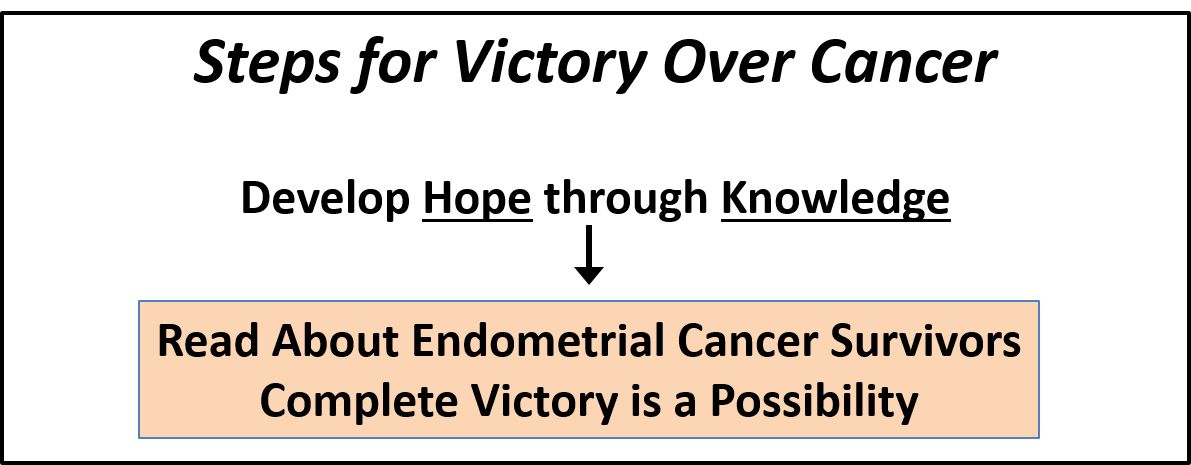Endometrial Cancer Survivor Stories
Dr. Robert Nagourney
Rational Therapeutics

The endometrial cancer survivor story on this page is excerpted from a patient with advanced endometrial cancer that received customized chemotherapy guided by the tumor functional screening methodology used by Dr. Robert Nagourney of Rational Therapeutics. A more detailed discussion of standard of care chemotherapy and of the customized chemotherapy guided by Dr. Nagourney’s technology can be found on our Cancer Therapy Options page.
One of our recommended Right Doctors, Dr. Keith Block uses the services of Rational Therapeutics to develop his customized integrated therapy tailored to each cancer patient he treats. Dr. Block has this to say about Dr. Nagourney:
“Dr. Robert Nagourney has earned international recognition as the most prominent leader in the field of chemosensitivity testing. For over two decades, my medical staff and I have included his chemosensitivity assay as an invaluable tool in helping us select the optimal chemotherapy regimen for our patients. A more primitive proliferative assay led many to reject such testing early on. However, Dr. Nagourney's pioneering work, developing instead a more prominent apoptotic (programmed cell death) assay, has benefitted innumerable cancer patients and played a pivotal role in their treatment response and treatment outcome. I believe all patients deserve the quality of information that Robert's testing provides, and that in the future, oncology practices will routinely incorporate such testing into the optimal care for patients.”
And now for the Endometrial Cancer Survival Story.
Endometrial Cancer Survivor-Tina
Endometrial Cancer-Stage IV
Below is the Tina's Endometrial Cancer Survivor Story:
Healthy has been my lifestyle for as long as I can remember. I eat mostly fresh fruits, vegetables and fish. My exercise regimen has always been demanding and rewarding. During my yearly GYN check-up in February of 2008, my vaginal ultrasound revealed my uterus had become thick. A follow up biopsy revealed endometrial cancer, more specifically uterine papillary serous carcinoma, "UPSC".
After completing a radical hysterectomy, it was determined that I had stage IV cancer that had migrated to my liver and peritoneum. A follow up course of chemotherapy was prescribed.
We initiated an extensive search for local oncologists and solicited their opinion for the most effective chemotherapy. Local knowledge of UPSC treatment was lacking. Our research discovered a Phase I/II UPSC clinical research study at M.D. Anderson Hospital in Houston, TX. Our choice to seek treatment at M.D. Anderson was guided by their reputation of success in treating cancer. The trial randomly assigned patients to Taxol or to Taxol plus an experimental drug. I was assigned to the Taxol arm and received Taxol every three weeks for six treatments. To test the success of my chemotherapy, a CT scan was done and revealed no evidence of cancer in September of 2008.
When we returned to M.D. Anderson Hospital in January 2009 for a follow up, I pointed out a small bump on the right side of my groin and requested a needle biopsy. The biopsy results indicated that the cancer had returned and a subsequent PET scan confirmed this. The oncologist at M.D. Anderson advised me that the chemotherapy had been ineffective and that they had nothing further to offer. My oncologist stated that I had about 6-8 months to live.
Dismayed by the news, we remembered that when we had first investigated cancer treatment options, one oncologist/scientist located in Long Beach, California had been strongly recommended. His name was Dr. Robert Nagourney, the medical and laboratory director of Rational Therapeutics.
Upon returning to Los Angeles from Houston, we immediately made an appointment. Dr. Nagourney scheduled a surgical biopsy of the tumor in my groin to allow him to analyze the activity of the drugs/combinations on my tumor.
One week later, Dr. Nagourney contacted us and told us the good news. He had identified excellent activity for a two-drug combination that he had previously used successfully in ovarian, breast, and cervical cancer patients. On March 6, 2009, I began the first of a series of six treatments. By the third course my tumor marker (CA 125) had returned to normal and my PET scan was clean.
After the sixth cycle, I am in complete remission and now continue to receive maintenance therapy about once per month. The "death sentence" that I received in Texas has been commuted and I am enjoying every day of my life thanks to our willingness to go the extra mile and our good fortune in finding Dr. Nagourney.
NOTE: The above account was excerpted and summarized from rational-t.com
Additional Cancer Survivor Stories
For cancer survivor stores of people with other types of cancer see our Cancer Survivor Stories page